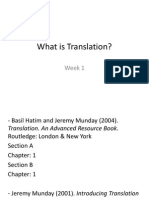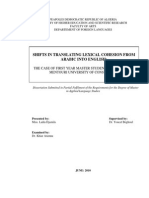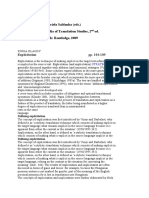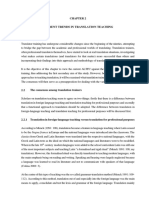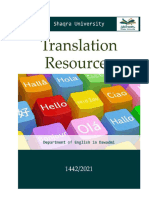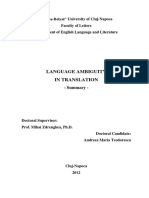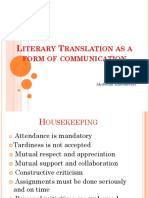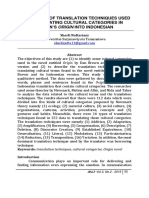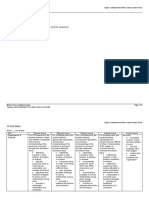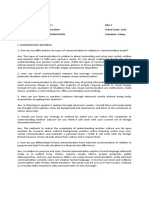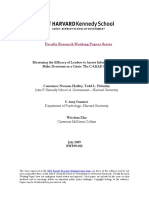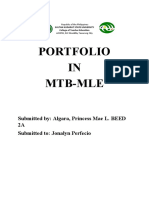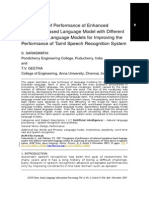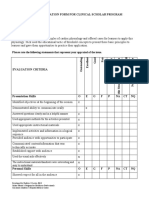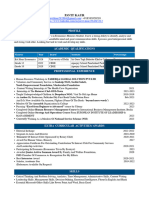Meeting 1
ENGLISH –
INDONESIAN
TRANSLATION
WORKSHOP
� • Reproducing in the receptor language the closest natural equivalence of the
source language message, first in terms of meaning and secondly in terms of
style (Nida, 1969, p. 12).
• Replacing textual material in one language by equivalent textual material in
another language (Catford, 1978, p. 20).
DEFINITION • Transferring the meaning of the source language into the receptor language.
OF This is done by going from the form of the first language to the form of a
second language by way of semantic structure. It is meaning which is being
TRANSLATION transferred and must be held constant (Larson, 1984, p. 3).
• Rendering the meaning of a text into another language in the way that the
author intended the text (Newmark, 1988, p. 5).
• Translation is a kind of activity which inevitably involves at least two
languages and two cultural traditions (Toury in James, 2000).
� Equivalence was meant to indicate that source text (ST) and
target text (TT) share some kind of “sameness” (Panao,
2013).
EQUIVALENCE
IN
TRANSLATION Nida (1960) stated that in formal equivalence the TT
resembles (=mirip) very much the ST in both form and
content whereas in dynamic equivalence an effort is made
to convey the ST message in the TT as naturally (=alamiah)
as possible.
� TRANSLATION TECHNIQUES
• Molina and Albir explain five basic characteristics of translation techniques:
a) Translation techniques affect the translation results.
b) Translation techniques compare SL with TL.
c) Translation techniques affect the smallest units of text, for example words, phrases, and
sentences.
d) Translation techniques are natural and contextual discursive (logical).
e) Translation techniques are functional.
While translation methods relate to whole texts, translation techniques are used for sentences
and the smaller units of language. (Newmark, 1988, p. 81)
��• Borrowing
Molina and Albir (2002) argued that borrowing is a translation technique using words or
expressions directly from other languages (p. 510). It is the loan word or borrowed phrase
purely or without change taken from the original language. For example the word ‘lobby’
taken from English
• Calque
Richards (1992) claimed that calque is to the type of loan translation or borrowing because this
translation technique translates the morpheme or word of a language into equivalent
morphemes or words into other languages (p. 44).
Calques can be seen often in international and specialized fields, such as “quality assurance”
or “aseguramiento de calidad” in Spanish.
�• Literal
The third direct technique is literal translation. Molina and Albir (2002) categorized it into
word by word translation technique because this technique tries to translate a word or phrase
word by word or word for word (p. 501).
ST (Sp): El equipo experimentado
TT (E) : The experienced team
It is normally applied only to languages that are very close to each other culturally and is only
acceptable if the same syntax, style, and meaning are maintained in the translated text.
�• Transposition
Molina dan Albir (2002) defined that transposition is to change a grammatical category’ (p. 510).
English plural pronouns are translated to a single noun in Indonesian.
ST: a pair of glasses
TT: sepasang kacamata (not kacamata-kacamata)
b) Indonesian adjective repetition is shifted from English adverb describing the plural subject.
ST: The houses in Jakarta are built beautifully.
TT: Rumah di Jakarta bagus-bagus.
c) English adjective + noun is transposed to Indonesian noun + adjective
ST : beautiful woman
TT : wanita (yang) cantik
�• Modulation
Modulation consists of using a phrase that is different in the source and target languages to convey the same idea:
Te lo dejo means literally I leave it to you but translates better as You can have it.
• Compensation
In general terms compensation can be used when something cannot be translated, and the meaning that is lost is
expressed somewhere else in the translated text.
The translation of the object ‘Me’ as a language unit into Indonesian question word(s) ‘Apa’ or ‘Apaan’ is one
interesting example.
ST: A) ‘Why don’t you write a factual narrative story?’ he asked.
(B) ‘Me?’ exclaimed Mr. Richards, for the first time in his life regardless of grammar.
TT: (A) ‘Mengapa Anda tidak menulis sebuah cerita nyata saja?’ tanyanya.
(B) ‘Apa?’ teriak Tuan Richards, untuk pertama kali dalam hidupnya lupa pada tata bahasa
�• Adaptation
Adaptation occurs when something specific to one language culture is expressed in a totally
different way that is familiar or appropriate to another language culture.
• Description
Molina dan Albir (2002) claimed that description is a translation technique that replaces a term
or phrase with a description of its shape and/or function. It is to replace a term or expression
with a description of its form or/and function (p. 510)
ST: nasi tumpeng
TT: steamed rice designed in a cone shape
�TRANSLATION METHODS
�• Foreignization is the strategy of retaining information from the source text, and involves
deliberately breaking the conventions of the target language to preserve its meaning (Gile,
2009).
• Domestication is the strategy of making text closely conform to the culture of the language
being translated to, which may involve the loss of information from the source text (Gile,
2009).
�• References
Gil-Bardají,Anna. 2009. Procedures, techniques, strategies: Translation process operators.
Perspectives Studies in Translatology 17(3):161-173. DOI: 10.1080/09076760903249372
Hartono, Rudi. 2020. Translation Techniques and Methods. LLPM: Semarang. Indonesia
https://www.interproinc.com/blog/translation-techniques
https://dubbingking.com/translation-techniques-compensating-for-differences-between-langua
ges/
�THANK YOU




